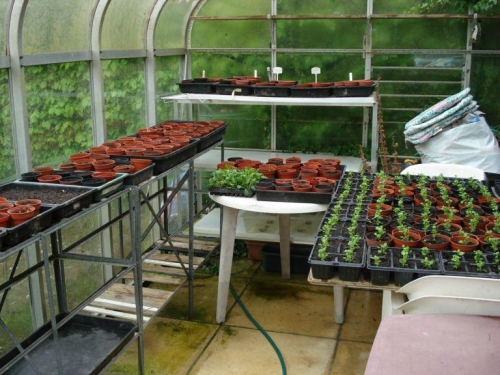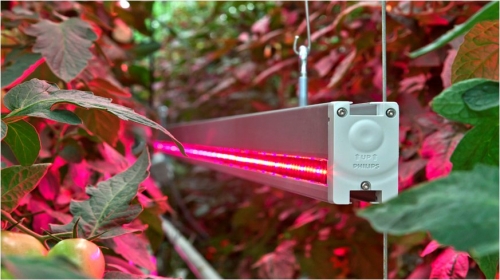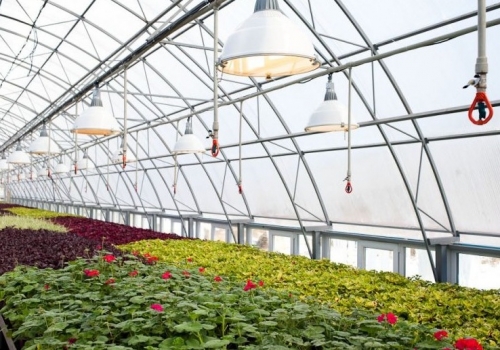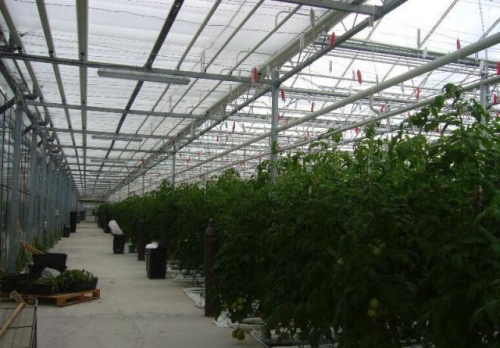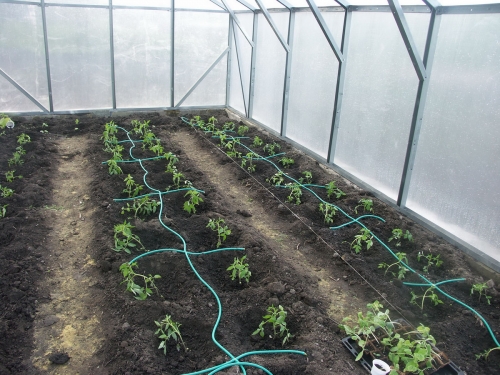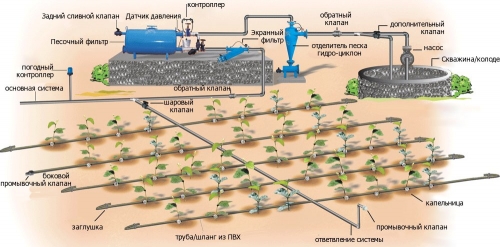Each developer is faced with the question of the exterior decoration of the building. The cladding at the same time ...
|
|
It is pointless to prove that for a comfortable year -round residence in the cottage in ... |
The kitchen is the most visited place in the house. The floor in this room is usually ... |
Organization of lighting, shade and watering in a greenhouse
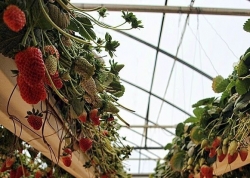
Summer frosts, strong gusts of wind, tropical heat are considered typical phenomena in the middle lane. You can protect your harvest from the cataclysms of nature and temperature differences with the help of covering material, which helps to maintain the desired temperature and protect fruit and vegetable crops from the cold, refresh and protect plants from drying out. However, along with temperature and humidity for plant growth, lighting is of great importance. The correct use of light and shadow helps summer residents to achieve the best results.
Table of contents:
Lighting greenhouses
One of the important conditions for the development and growth of plants is light. Cultures only with good lighting get enough energy for photosynthesis. Different specimens have a different need for lighting, and everything depends, first of all, on the variety, phase of development and the growing season.
Types of plants
When installing a greenhouse or building a greenhouse with your own hands, it is advisable to take into account its placement relative to the cardinal points. In order for the greenhouse to receive natural light throughout the day, it is better to put it in the direction of the south of the north, the glass slopes of the roof will be directed to the west and south. This allows the light to enter the room on one side of half a day and on the other half a day. In the greenhouse sets in this way, plants evenly develop without curvature in all directions.
But in early spring, in the autumn and winter cold daylight hours are not long, which is not suitable for the normal growth of vegetable fruit crops, herbs and flowers. And this can provoke a significant decrease in the crop or reduction of flowering time, and can even cause the death of growing. To avoid such a deplorable result, it is recommended to extend the daylight hours and provide cultures as much light as they need.
However, remember that various species of plants for the duration of the day react differently. There are two types of plants: cultures of a long daylight day (onions, cabbage, garlic, root crops) and copies of a short daylight day (eggplant, pepper, beans, zucchini, tomatoes).
The first type needs lighting, the duration of which is more than 12 hours, and the second type requires light 8 to 10 hours a day.
It is very important to observe the correct lighting mode, because flowering decorative plants in this case may not bloom at all, but exclusively drive a vegetative mass; Root crops, on the contrary, will bloom like a flowerbed, but they will not give a crop at all; Greens (salad, dill, onion feather) will expel the arrows.
Installation of electrical wiring
In order to extend daylight hours in greenhouses, you need to install additional lighting. But before buying lamps, it is necessary to calculate the price of the construction of the greenhouse and carry out electric wiring. Firstly, you need to lay the main cable to the greenhouse. This is customary to do either an underground way, or air at a safe height.
Secondly, the wiring is mounted in the greenhouse itself. For this, a cable is suitable, which has a section diameter of at least 2 squares. It is better if the cable is of two colors one color for the phase, the other for zero. It is also necessary to stock up on the corrugation, in which the wires are hidden. After that, you should connect all the wires to a separate shield, to which all electrical appliances will be connected.
Thirdly, in a greenhouse it is worth placing the right number of sockets, which have fuse that it is recommended to supply the entire greenhouse for quick de-energizing the entire greenhouse. When installing electrical wiring, you should not forget that the greenhouse acts as a room with high humidity, so be sure to isolate all the joints of the wires. The lighting devices used must be moisture resistant.
Lamps for greenhouses
They produce a great many greenhouses for greenhouses, which differ in purpose and price, radiation intensity and spectrum. The main advantage of fluorescent lamps can be seen in the video about the construction of greenhouses. It lies in the fact that they do not heat up, so they do not at all affect the temperature in the greenhouse. The radiation spectrum is considered favorable for plants. It is better to take LD or LDC lamps, in the spectrum of which the blue rays prevail, which are needed for the process of photosynthesis. Another plus in their favor is the efficiency of electricity consumption.
In different periods of the growing season, sodium lamps are the best for lighting greenhouses. For growing green mass, DRIZ lamps are best suited for spectral radiation, but they are not suitable for flowering and fruiting. For such purposes, it is necessary to buy a dnet lamp, which is given greater energy to plants during fruiting.
Energy -saving lamps are suitable for any phases of cultural development, you only need to choose the desired spectrum. During the period of growth, select the ESL of the blue spectrum, during flowering and fruiting, give preference to the ESL of the Red Spectrum. These lamps are economical and convenient to use because they are equipped with a built -in starting unit.
Metalloid lamps are considered the most advanced for illuminating fruit and vegetable crops. They are characterized by a high power, a suitable radiation spectrum, a significant resource of operation. The disadvantage of such products is their cost, they are quite expensive.
Plant shade
If in the early spring, in the late autumn months and the winter cold, gardeners strive to provide plants cultivated in a greenhouse, maximum illumination, then in a warm season the heat and radiant solar energy falls into the greenhouse. Without the use of different methods of crushing culture, they can stop their growth and even die. Touching measures should be carried out along with ensuring irrigation of plants and ventilation.
If the structure is equipped with an effective ventilation system, the plant may not need a shade. If in a greenhouse, specimens with different need for light are cultivated, then under the species that require intense lighting, it is worth placing trellishes. It should be remembered when an excessive amount of light is observed, the leaves turn red in crops. This signals the need for their shading.
Methods of shade
Plants are shaded in the external and internal way. It will turn out to provide this with 3 methods: cover a transparent coating, spray the protective fluid on the glazed surface, which will prevent the penetration of light into the greenhouse, or close the greenhouse from the light with some material.
As a shade of fluid, lime whitewashing or emulsion paint diluted with water used to be used. However, these substances have a significant drawback: at the end of the summer season they will have to scrape them by using a hard brush, and this work is quite laborious and requires precious time.
At the moment, compounds have been developed that can be easily removed from the painted surface, but along with this, they are not washed off during the rain. However, a layer of such a substance is able to gradually become thinner and lose its protective properties, and it must be updated from time to time. It is worth performing such work exclusively in sunny dry weather.
The inconvenience of the use of a liquid shade lies in the fact that the substances remain constantly on the coating, so plants in cloudy weather begin to experience a lack of heat and lighting. In connection with this trend, it is best to use internal and external screens for shading.
Shadeing screens
Substituting screens can be installed outside the greenhouse, at any time they can be turned if necessary. The lifting blinds can only be suspended indoors of the greenhouse. Watch the video of how to make a greenhouse and how to install shading screens. External screens contribute to a decrease in the light permeability of the transparent coating of the greenhouse and prevent an excessive increase in temperature inside the structure. In addition, during the period of spring frosts, such devices create reliable protection for plants.
The shade of the screens that install the rooms of the greenhouse are less effective than external devices. They reduce the intensity of light, but at the same time they pass the heat into the greenhouse, which is why the temperature rises in the structure.
In addition, it is inconvenient to use internal screens in those buildings of protected soil where decorative crops with large colors and leaves are grown. Thus, one should give preference to their location from the outside of the greenhouse, and so that they are not damaged by strong gusts of wind, it is necessary to ensure their fastening to the elements of the frame of the greenhouse.

The most effective are shadeing screens that are made of wooden or plastic rails. They serve for a long time, easily straighten out and remove. Although a little light passes between some rails of such structures, this does not cause any harm to cultures, because during the day the angle of fall of rays changes slowly. In addition, screens that are made in the form of white plastic blinds have proven themselves well.
If you are not often on your garden plot, it makes sense to automate the process of raising and lowering the screens by supplying devices by a motor with built -in photosensitive sensors that are able to regulate the operation of the system. In addition, for shading, you can use improvised materials: a light -permeable plastic film and burlap, which is customary to be attached from the outside of the structure.
Organization of irrigation
Watering in a greenhouse has its own characteristics. If it is wrong to organize it, then plants may die from a lack or excess of moisture. Watering cultures with a watering can or using a hose takes a lot of time and effort. In this regard, it is more advisable to equip an automatic watering system in a greenhouse.
Capillary system
For crops that are grown in pots, a capillary watering system is better suited, the principle of operation of which is based on the action of capillary power of wet sand. According to the narrow spaces, which form between individual particles, water rises and enters pots through drainage holes.
For the device of the capillary system, the bottom of the rack, cuvette or pallet of the plastic film should be laid, and then place a layer of sand on it, which has a thickness of 5 8 centimeters. Its surface must be regularly watered from a watering can or provide a moisture using an automatic device made from an inverted bottle upside down with a nozzle, which is fixed in a special holder.
The sand is moistened with water from the bottle as it dries. A more complex apparatus is a pressure reservoir, which is connected to the central water supply system. After the opening of a special valve, water enters the sand.
On top you need to install pots with plants and deepen them with rotational movements by about 3 centimeters in such a way that the sand fills completely drainage holes.
Drip irrigation system
Plants can also be watered using tubular systems. Among them, the drip irrigation system gained the greatest popularity. It is a system of pipes that pass over the racks of the pipes, and in which there are holes that are located above each plant in the bed or above the pot. You can connect thin tubes to each hole. Or you can provide a hole with a nozzle.
This technique is well suited for those crops that need constant soil moisture. The water supply source must be connected to the timer and valve with the solenoid in order to ensure the supply of the desired amount of water through specific periods of time.
When you practice the drip irrigation system, it is recommended to periodically inspect each plant. Driven irrigation helps to provide all plants with the same amount of moisture, regardless of individual species preferences. As a result, in some areas, the Earth may turn out to be overly moistened, on the rest too dry.
The shortcomings will have to be corrected manually: it is necessary to water those plants under which it turned out to be slightly dry, and those of the cultures that do not require moisture can be temporarily disconnected from the overall drip irrigation system and wait until the soil dries under them, then they should be resumed continuous watering .
Thus, after you made a greenhouse from the profile and covered it with the selected material, you can begin to arrange the lighting and shade in the greenhouse, and the watering system in the greenhouse is also very important. A separate item should be prescribed by the organization of irrigation of plants located in pots and on the beds.

